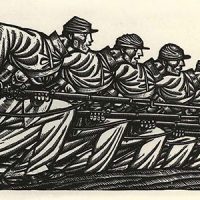Underground Railroad
Underground Railroad: Before the Civil War, Delaware was an important link in the Underground Railroad system of helping runaway slaves travel to freedom in Canada. Situated between the southern slave-holding states and the northern anti-slave states, Delaware was traveled by hundreds of escaping slaves each year. They were aided by rescuers who, for religious or moral reasons, opposed slavery and defied the Fugitive Slave Laws.
Beginning in 1793, the federal government passed a series of laws allowing slaveholders to seize fugitive slaves in free states and return them to slavery. The same year, however, the Emancipation Act in Canada not only outlawed the importation of slaves into that country, but also limited the ability of slaveholders to take back runaways. Those who most actively assisted slaves to escape were members of the free Black community, Northern abolitionists, and religious groups (particularly the Quakers and the African-American congregations). Estimates of the number of slaves who reached freedom vary greatly, from 40,000 to 100,000 during the sixty years before the Civil War.
Though neither underground nor a railroad, the system was named because its activities had to be carried out in secret and because railway terms were used to refer to the conduct of the system. Various routes were lines, stopping places were called stations, those who aided along the way were conductors, and the slaves were known as packages or freight. One of the most important conductors in the system was Thomas Garrett, a Quaker from Wilmington. After the escapees traveled north through rural Maryland and Delaware, Garrett arranged their passage, often by steamboat, to Philadelphia which was a central station run by a large free-Black religious community and the strongly abolitionist Quakers. Garrett was often aided by Harriet Tubman, possibly the most famous Black conductor on the Railroad.
Among the Underground Railroad stations in Delaware were Wild Cat Manor and Great Geneva in Camden, owned by the Quaker Hunn family; Star Hill African Methodist Episcopal Church in Star Hill, a small rural free African-American church; Appoquinimink Friends Meeting House in Odessa; the John Dickinson Plantation in Dover; the Clearfield Farm, owned by the Corbet family in Smyrna; and the Mother African Union Protestant Church and the home of Thomas Garrett, both in Wilmington.
Special Collections Book Sources:
African Americans: Voices of Triumph. Leadership. Alexandria, VA : Time Life Books, 1993.
African Americans: Voices of Triumph. Perseverance. Alexandria, VA : Time-Life Custom Publishers, 1993.
Bayley, S. A Narrative of Some Remarkable Incidents in the Life of Solomon Bayley: Formerly a slave in the state of Delaware, North America. London: Harvey and Darton : W. Baynes & Son: P. Youngman, 1825.
Bennett, G. F. Early Architecture of Delaware. Wilmington, DE : Historical Press, Inc.; New York : C. T. Waugh & Co, 1932.
Bently, J. Dear Friend: Thomas Garrett and William Still, collaborators on the Underground Railroad. New York : Cobblehill Books/Dutton, 1997.
Biggs, M. Delaware a Photographic Journey. Wilmington, DE : Jared Co, 1986.
Bradford, S. E. H. Scenes in the Life of Harriet Tubman. Auburn, NY : W. J. Moses, Printer, 1869.
Essah, P. A house divided: Slavery and Emancipation in Delaware, 1638-1865. Charlottesville : University Press of Virginia, 1996.
Essah, P. Slavery and Freedom in the First State: The history of blacks in Delaware from the colonial period to 1865. Thesis, 1985.
Guccione, L. D. Come Morning. Minneapolis : Carolroda Books, 1995.
Jubilee songs: As Sung By the Jubilee Singers of Fisk University, (Nashville, TN) under the auspices of the American Missionary Association. New York; Chicago : Bigelow & Main, 1872.
MacDonald, B. H. Historic Landmarks of Delaware and the Eastern Shore. Delaware State Society. Daughters of the American Colonists, 1963.
McGowan, J. A. Station Master on the Underground Railroad: The life and letters of Thomas Garret. Moylan, PA : Whimsie Press, 1977.
Narrative and Confessions of Lucretia P. Cannon. New York : Printed for the publishers, 1841.
Shields, J. The infamous Patty Cannon in History and Legend. Dover, DE : Bibliotheca Literaria Press, 1990.
Smedley, R. C. History of the Underground Railroad in Chester and the Neighboring Counties of Pennsylvania. Lancaster, PA : Office of the Journal, 1883.
Still, W. The Underground Rail Road. Chicago : Johnson Publishers, 1970.
Ten dollars reward. S.l. : S. N. [1790?]
Townsend, G.A. The Entailed Hat: or Patty Cannon's Times, a Romance. Cambridge, MD : Tidewater Publishers, 1955.
Wallace, P. B. Colonial Churches and Meeting houses: Pennsylvania, New Jersey and Delaware. New York : Architectural Book Publishing Co., 1931.
Sampling of Special Collections Underground Railroad Holdings:
-
The Underground Railroad in DelawareFinding Aid material about the Underground Railroad
-
Fort Sumter to the Appomattox Courthouse: the American Civil War (ONLINE EXHIBITION)
 Spring 2015
Spring 2015
2015 marked the 150th anniversary of Confederate General Robert E. Lee's surrender at Appomattox, Virginia, effectively ending the American Civil War, which had officially commenced on April 12, 1861, when Confederate artillery fired on Fort Sumter in Charleston, South Carolina.
-
Thomas Garrett, 1789-1871 : a memorial address delivered by the Reverend William P. Tilden in the First Uniterian Church, Wilmington, Delaware, January 28, 1889 byCall Number: E449 .G23Publication Date: 1935
-
Opening the door to freedom : the struggle for equality in Delaware byCall Number: MEDIA E445.D3 O63 1990Publication Date: 1990
-
Underground Railroad in Delaware, Maryland, and West Virginia by
Call Number: E 450 .S98 2004ISBN: 9780811731430Publication Date: 2004Delaware Collection. In a companion volume to his highly regarded Underground Railroad in Pennsylvania, Switala focuses on the escaped-slave network in the eastern border states.

